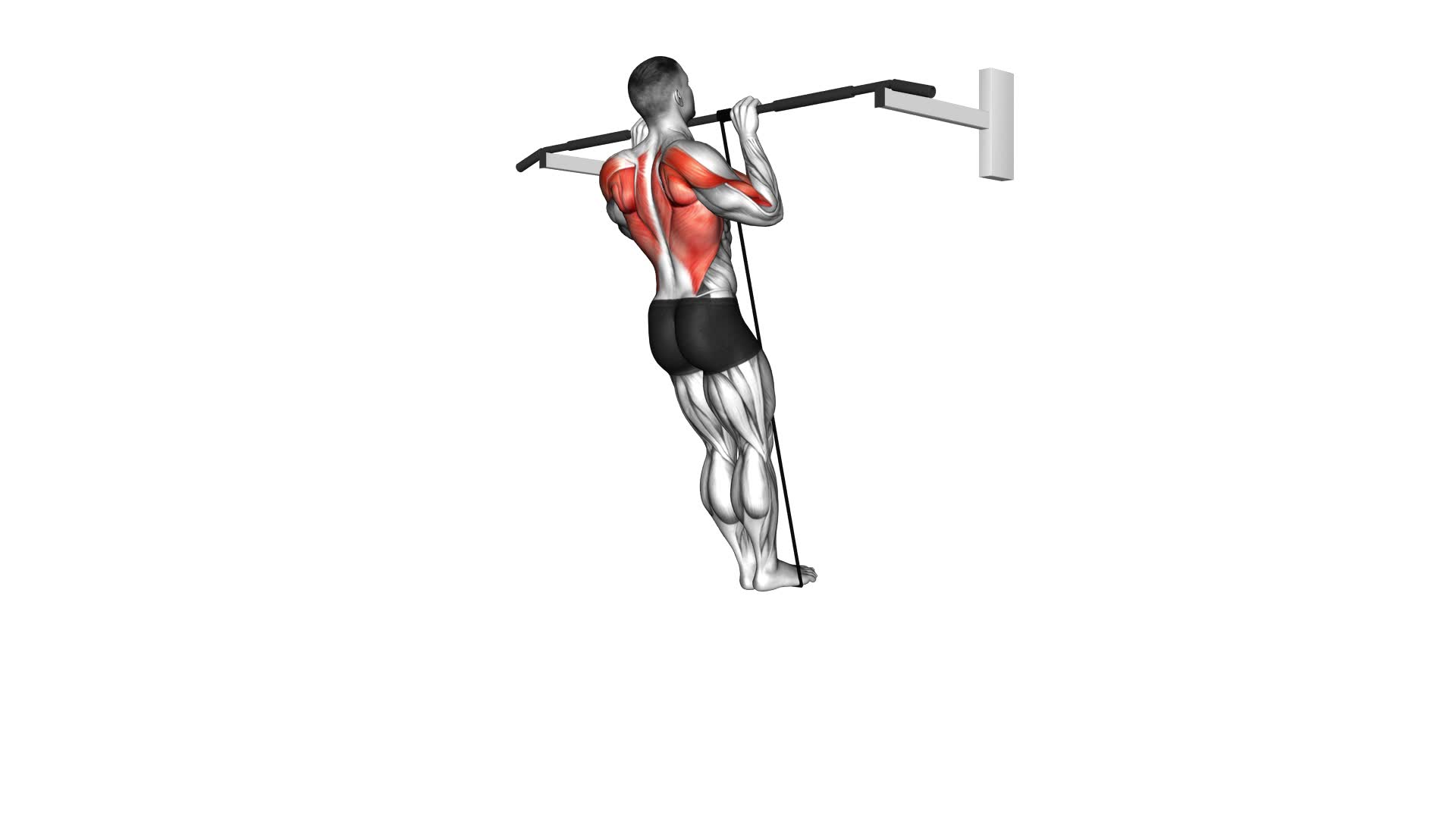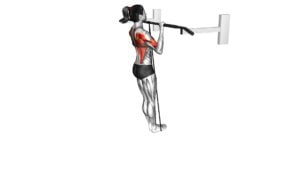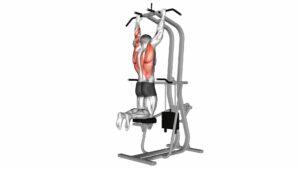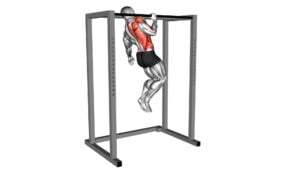Band Assisted Pull-Up (VERSION 3) – Video Exercise Guide & Tips

Are you struggling to do pull-ups on your own? Look no further!
Watch This Exercise Video
In this video exercise guide, we'll show you how to master the Band Assisted Pull-Up (Version 3). With the help of resistance bands, you'll be able to gradually build strength and improve your pull-up technique.
Whether you're a beginner or looking to take your pull-ups to the next level, this guide has got you covered.
Get ready to conquer those pull-ups and achieve your fitness goals!
Key Takeaways
- Band assisted pull-ups can lead to increased muscle activation and improved overall muscle development in the back, shoulders, and arms.
- Proper form and technique are crucial for maximizing the benefits of band assisted pull-ups and reducing the risk of injury.
- Selecting the right resistance band and avoiding common mistakes such as using excessive weights or compromising form are important for safety and effectiveness.
- Gradual progression, focusing on maintaining proper form and technique, is key to achieving long-term success and minimizing the risk of setbacks.
Benefits of Band Assisted Pull-Ups
Band assisted pull-ups offer numerous benefits to help you build strength and improve your upper body muscles. One of the key benefits is increased muscle activation. By using resistance bands to assist you in completing the exercise, you're able to target and activate the muscles in your back, shoulders, and arms more effectively. This increased muscle activation not only helps you build strength but also improves your overall muscle development.
Another benefit of band assisted pull-ups is injury prevention. By using the bands, you reduce the amount of stress and strain on your joints, particularly your shoulders and elbows. This can be especially beneficial for individuals who may have pre-existing shoulder or elbow issues. The bands provide support and assistance, allowing you to perform the exercise with proper form and technique, minimizing the risk of injury.
Proper form and technique are crucial when performing band assisted pull-ups to maximize the benefits and minimize the risk of injury. It's important to maintain a straight back, engage your core, and use controlled movements throughout the exercise. By focusing on proper form, you can ensure that you're targeting the intended muscles and getting the most out of your workout.
In the next section, we'll discuss the proper form and technique for performing band assisted pull-ups.
Proper Form and Technique
How can you ensure proper form and technique while performing band assisted pull-ups? Proper form and technique are crucial for maximizing the benefits of band assisted pull-ups and preventing injuries. Here are three important points to keep in mind:
- Maintain a straight body position: To ensure proper form, keep your body straight throughout the exercise. Avoid swinging or using momentum to pull yourself up. This not only reduces the effectiveness of the exercise but also puts unnecessary strain on your muscles and joints.
- Engage your core muscles: One common mistake is neglecting to engage the core muscles during band assisted pull-ups. By actively contracting your abdominal muscles, you stabilize your body and maintain proper alignment. This helps to prevent excessive arching of the back and supports the movement.
- Control the descent: Another common misconception is to let yourself drop quickly after pulling up. Instead, focus on controlling the descent in a slow and controlled manner. This eccentric phase of the exercise is just as important as the upward pull and helps to strengthen your muscles more effectively.
Selecting the Right Resistance Band
To select the appropriate resistance band for band assisted pull-ups, you should consider your current strength and fitness level. Finding the right band tension is crucial to ensure that you're effectively using the resistance bands to assist you in performing pull-ups. If the band tension is too light, you may not be getting enough assistance and won't be able to perform the exercise correctly. On the other hand, if the band tension is too heavy, it may be difficult for you to complete the pull-up movement with proper form.
One common mistake when using resistance bands is selecting a band that's too challenging for your current strength level. This can lead to poor technique and potential injuries. It's important to start with a band that provides enough assistance for you to perform the exercise with good form. As you become stronger, you can gradually decrease the band tension and challenge yourself more.
Another mistake isn't checking the condition of the resistance bands regularly. Over time, bands can wear out and lose their elasticity, which can affect their tension. Make sure to inspect your bands for any signs of wear and tear, such as small tears or fraying. If you notice any damage, it's important to replace the band to maintain safety and effectiveness during your workouts.
Progression Tips for Beginners
As a beginner, you can gradually increase your strength and improve your form by following these progression tips:
- Common mistakes to avoid when doing band assisted pull ups: When performing band assisted pull ups, it's important to avoid these common mistakes:
- relying too heavily on the band for assistance
- using momentum to swing yourself up
- neglecting proper technique and form
Remember to engage your core, keep your shoulders down and back, and pull yourself up using your back muscles.
- How to gradually decrease band assistance for beginners: To gradually decrease band assistance, start by using a band with higher resistance and gradually work your way down to a lighter band. As you become more comfortable and stronger, try using a thinner band or even no band at all. You can also try reducing the number of bands used or using a combination of band and bodyweight assistance.
- Transition to advanced variations and modifications: Once you have mastered the band assisted pull up, you can start exploring advanced variations and modifications. These can include weighted pull ups, wide grip pull ups, or one-arm pull ups. Remember to always challenge yourself while maintaining proper form and technique.
Advanced Variations and Modifications
Explore advanced variations and modifications to enhance your band assisted pull-up training. Once you have mastered the basic band assisted pull-up, you can progress to more challenging exercises to further strengthen your upper body and improve your pull-up technique.
One advanced modification is using a heavier resistance band. By using a thicker band, you'll increase the difficulty of the exercise and engage more muscles.
Another advanced training technique is performing pull-ups with a pause at the top. This requires you to hold the top position of the pull-up for a few seconds before lowering yourself back down. This pause adds an extra challenge and helps to build strength and control in the upper body.
Additionally, you can try incorporating explosive movements into your pull-up routine. This includes performing pull-ups with a quick and powerful upward movement, allowing you to develop more explosive strength.
Remember to always prioritize proper form and technique when attempting advanced modifications and training techniques.
Frequently Asked Questions
How Long Does It Take to Progress From Band-Assisted Pull-Ups to Unassisted Pull-Ups?
To progress from band-assisted pull-ups to unassisted pull-ups, the timeline varies based on individual factors such as strength and consistency.
The benefits of using band assistance include building strength, improving form, and gradually reducing reliance on the band.
It's important to follow a progressive training program, gradually decreasing band assistance and increasing repetitions.
With consistent effort and proper technique, you can expect to see progress within a few weeks to a few months.
Can Band-Assisted Pull-Ups Help With Improving Grip Strength?
Band-assisted pull-ups can definitely help improve your grip strength. By using resistance bands to assist you during the exercise, you're able to focus more on the gripping aspect of the movement. This constant engagement of your grip muscles helps to strengthen them over time.
In addition to improving grip strength, band-assisted pull-ups also offer other benefits such as building upper body strength and improving overall stability. So incorporating them into your workout routine can be highly beneficial.
Are There Any Specific Tips for Preventing Shoulder Injuries While Doing Band-Assisted Pull-Ups?
To prevent shoulder injuries during band-assisted pull-ups, it's important to engage your back muscles properly. Focus on pulling your shoulder blades down and back, keeping your chest lifted. Avoid shrugging your shoulders or relying solely on your arms to do the work.
Can Band-Assisted Pull-Ups Be Effective for Individuals With Lower Body Strength Imbalances?
Band-assisted pull-ups can be effective for individuals with lower body strength imbalances. By incorporating band resistance in pull-up training, you can focus on improving your upper body strength while still providing support for your lower body. This allows you to gradually build strength and work towards unassisted pull-ups.
The benefits of incorporating band resistance include increased muscle activation and improved stability. So, don't let lower body imbalances hold you back from reaping the benefits of band-assisted pull-ups for upper body strength.
Is It Recommended to Use a Specific Grip (Overhand, Underhand, or Neutral) While Performing Band-Assisted Pull-Ups?
When performing band-assisted pull-ups, it's recommended to use a specific grip. The grip you choose (overhand, underhand, or neutral) can have different benefits and target different muscle groups. Experiment with different grips to find what works best for you.
Additionally, if band-assisted pull-ups aren't effective for you, there are alternative assistance methods you can try, such as using a chair or a spotter. Don't be afraid to explore different options to achieve your fitness goals.
Conclusion
In conclusion, the band assisted pull-up is a highly effective exercise for building upper body strength and improving pull-up performance. By using resistance bands, individuals of all fitness levels can gradually increase their strength and work towards unassisted pull-ups.
Proper form and technique are essential for maximizing the benefits of this exercise. It's important to choose the appropriate resistance band and progress gradually to more advanced variations.
Incorporating band assisted pull-ups into your workout routine can lead to significant strength gains and improved overall fitness.

Author
Years ago, the spark of my life’s passion ignited in my mind the moment I stepped into the local gym for the first time. The inaugural bead of perspiration, the initial endeavor, the very first surge of endorphins, and a sense of pride that washed over me post-workout marked the beginning of my deep-seated interest in strength sports, fitness, and sports nutrition. This very curiosity blossomed rapidly into a profound fascination, propelling me to earn a Master’s degree in Physical Education from the Academy of Physical Education in Krakow, followed by a Sports Manager diploma from the Jagiellonian University. My journey of growth led me to gain more specialized qualifications, such as being a certified personal trainer with a focus on sports dietetics, a lifeguard, and an instructor for wellness and corrective gymnastics. Theoretical knowledge paired seamlessly with practical experience, reinforcing my belief that the transformation of individuals under my guidance was also a reflection of my personal growth. This belief holds true even today. Each day, I strive to push the boundaries and explore new realms. These realms gently elevate me to greater heights. The unique combination of passion for my field and the continuous quest for growth fuels my drive to break new ground.







